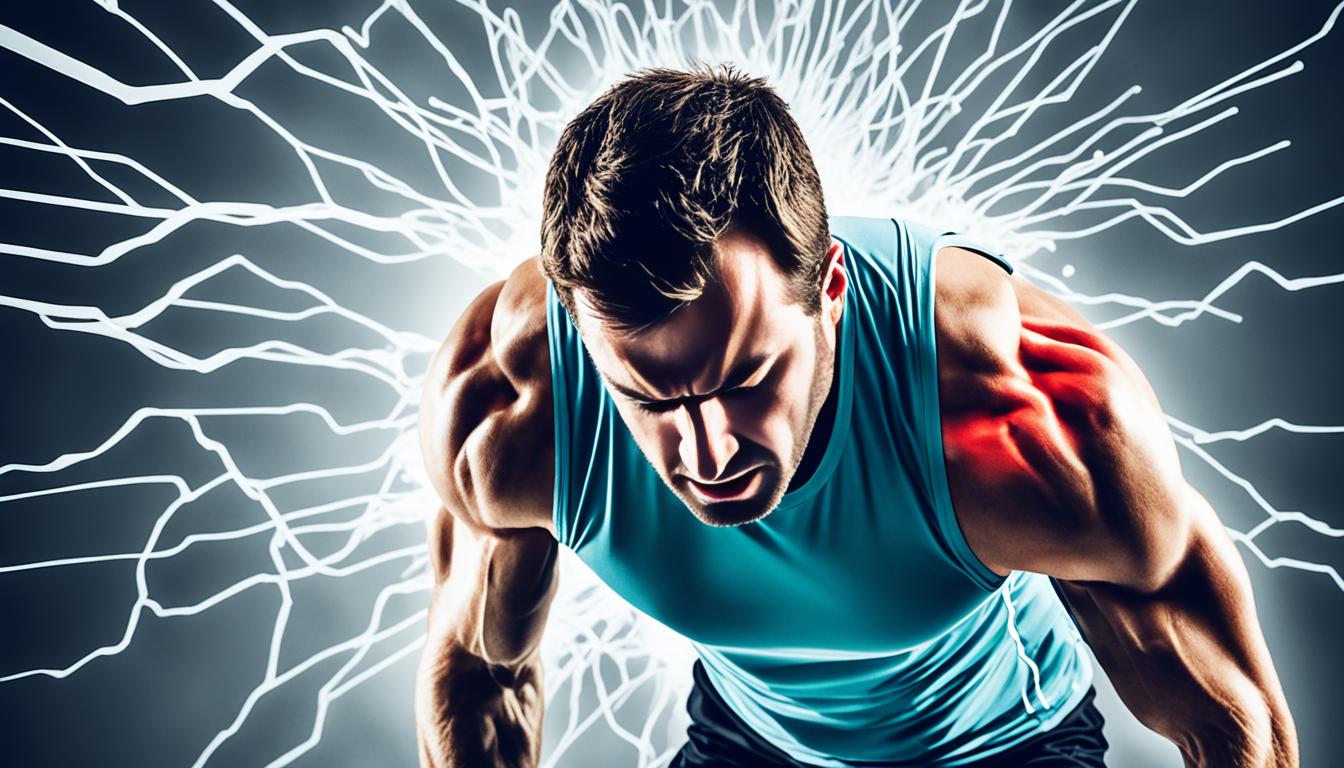Exercise headaches are a common type of headache. You might feel them during or after you work out. They can start when you do various exercises like running or lifting weights. These headaches cause a throbbing pain on both sides of your head. The pain can stay for many hours.
Key Takeaways:
- Exercise headaches, also known as exertion headaches, occur during or after physical activity.
- These headaches can be triggered by various forms of exercise, such as running or weightlifting.
- They are characterized by a throbbing pain on both sides of the head.
- The exact causes of exercise headaches are not fully understood.
- Diagnosis involves a comprehensive evaluation of symptoms and medical history.
- Stem cell therapy is an exciting advance in the treatment of exercise headaches.
Types of Exercise Headaches
Exercise headaches, known as exertion headaches, have different types. Knowing these types helps manage and stop them. Types include:
Gym-Induced Headaches
Gym-induced headaches happen during or after tough workouts. They cause throbbing pain on both head sides for hours.
Physical Activity Migraines
Exercise migraines trigger during aerobics, raising heart rate and blood pressure. You’ll feel severe throbbing, nausea, and find light and sound painful.
Running-Induced Headaches
Athletes and runners may get headaches during or after runs. These range from mild to severe, disturbing daily life.
Sports Headaches
Sports headaches hit those in intense sports. Actions like sprinting or sudden moves can trigger them.
Fitness Migraines
Post-workout migraines appear after high-intensity exercises. They’re severe, with pulsating pain, and can lower your ability to function.
Aerobic Activity Headaches
These headaches arise from aerobic exercises like cycling or dancing. They feel like a dull ache or throb on both head sides.
If you often get exercise headaches, see a doctor for help. They can find the right treatment for you. This can make your life better.
| Type of Exercise Headache | Characteristics |
|---|---|
| Gym-Induced Headaches | Pulsating pain on both sides of the head that can last for several hours. |
| Physical Activity Migraines | Severe throbbing pain accompanied by symptoms like nausea and sensitivity to light and sound. |
| Running-Induced Headaches | Headaches experienced during or after running, ranging from a dull ache to severe pain. |
| Sports Headaches | Exercise-related headaches triggered by intense physical activities like sprinting or jumping. |
| Fitness Migraines | Intense migraines following high-intensity workouts, often pulsating or throbbing in nature. |
| Aerobic Activity Headaches | Dull ache or throbbing pain during or after aerobic exercises. |
Causes and Risk Factors
The exact causes of exercise headaches aren’t fully known. It’s thought that a sudden rise in blood flow and pressure in the head’s blood vessels during exercise leads to them. This might cause blood vessels to grow bigger. It can also release chemicals, causing pain and inflammation.
Not drinking enough water is a possible risk for exercise headaches. If you’re dehydrated, blood vessels might shrink, upping the chances of a headache. People who often get migraines or tension headaches may find themselves more likely to get exercise headaches too.
Exercises like intense workouts, running, and lifting weights are linked to a higher headache risk. Such activities force the body to work hard, which could lead to headaches.
Several things might up the risk of exercise headaches, including:
- Working out in hot and humid weather.
- Having health issues like high blood pressure or heart disease.
- Taking certain medications, including those for blood pressure.
| Potential Causes | Risk Factors |
|---|---|
| Dehydration | Low fluid intake during exercise |
| History of migraines or tension headaches | Individuals with a pre-existing headache disorder |
| Intense physical activities | High-intensity workouts, running, weightlifting |
| Heat and humidity | Exercising in hot and humid conditions |
| Underlying medical conditions | High blood pressure, heart disease, vascular malformations |
| Medication | Blood pressure medications, vasodilators |
Advances in Diagnosis and Stem Cell Therapy for Exercise Headaches
When you get an exercise headache, doctors look at your symptoms, history, and do a checkup. They might want MRI or CT scans to check for other causes. This method helps them make the right diagnosis and plan the best treatment.
Stem cell therapy is a new and exciting way to treat these headaches. Stem cells can fix the tissues that cause the pain. This approach gives new hope to people with exercise-induced headaches.
In stem cell therapy, doctors put stem cells where they’re needed. These cells can turn into different types of cells and help the body fix itself. This treatment might reduce headaches and make life better for patients.
As we learn more about headaches, stem cell therapy becomes more promising. It’s a new option that might really help. With more work, it could change how we deal with exercise headache and give relief that lasts.

